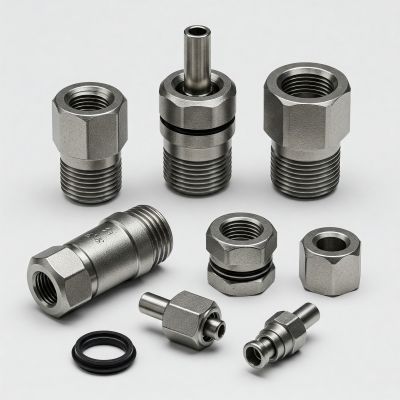The American Society for Testing and Materials (ASTM) plays a crucial role in standardizing stainless steel materials used across various industries. ASTM stainless steel standards ensure that materials meet specific quality, performance, and consistency requirements, making them reliable for critical applications.
In this comprehensive guide, we will explore ASTM stainless steel standards, their classifications, key specifications, common grades, mechanical and chemical properties, testing methods, selection criteria, and compliance requirements.
Understanding ASTM Stainless Steel Standards
ASTM stainless steel standards classify and regulate stainless steel based on its composition, mechanical properties, and intended applications. These standards establish guidelines for chemical composition, heat treatment, manufacturing processes, and testing requirements.
Industries such as construction, automotive, aerospace, and medical heavily rely on ASTM standards to ensure their stainless steel materials meet safety and performance expectations. By adhering to ASTM specifications, manufacturers and engineers can select the appropriate stainless steel for their applications with confidence.
Key ASTM Stainless Steel Specifications
ASTM has established numerous standards covering various forms of stainless steel. Some of the most commonly referenced specifications include:
➡️ ASTM A240 – Standard Specification for Chromium and Chromium-Nickel Stainless Steel Plate, Sheet, and Strip.
➡️ ASTM A276 – Standard Specification for Stainless Steel Bars and Shapes.
➡️ ASTM A312 – Standard Specification for Seamless, Welded, and Heavily Cold Worked Austenitic Stainless Steel Pipes.
➡️ ASTM A554 – Standard Specification for Mechanical Tubing Made of Welded Stainless Steel
➡️ ASTM A564 – Standard Specification for Hot-Rolled and Cold-Finished Age-Hardening Stainless Steel Bars and Shapes.
➡️ ASTM A580 – Standard Specification for Stainless Steel Wire.
These standards cover various stainless steel forms used in manufacturing, ensuring consistency across different applications.
Common ASTM Stainless Steel Grades and Their Applications
Several stainless steel grades fall under ASTM specifications, each suited for specific applications. Below are some of the most commonly used grades:
➡️ 304 (ASTM A240, A276, A312, etc.) – A widely used general-purpose stainless steel with excellent corrosion resistance.
➡️ 316 (ASTM A240, A276, A312, etc.) – A marine-grade stainless steel known for its superior corrosion resistance, particularly against chlorides.
➡️ 410 (ASTM A276, A580, etc.) – A hard martensitic stainless steel used in high-strength applications.
➡️ 430 (ASTM A240, A580, etc.) – A ferritic stainless steel offering good corrosion resistance and formability.
Each grade is tailored to specific environmental and mechanical demands, making it essential to select the right one based on application requirements.
Mechanical and Chemical Properties of ASTM Stainless Steels
ASTM stainless steels are defined by key mechanical and chemical properties, ensuring they perform optimally under specified conditions.
➡️ Mechanical Properties:
Tensile strength
Yield strength
Elongation
Hardness (Rockwell, Brinell, Vickers)
➡️ Chemical Properties:
Chromium, nickel, molybdenum content for corrosion resistance
Carbon levels affecting hardness and strength
Additional alloying elements for enhanced performance
These properties ensure material consistency and reliability across applications.
Testing and Quality Control Under ASTM Standards
ASTM standards define rigorous testing methods to guarantee stainless steel quality and performance. Common tests include:
➡️ Tensile Testing – Measures a material’s strength and elongation before breaking.
➡️ Hardness Testing – Determines the material’s resistance to deformation using Rockwell, Brinell, or Vickers scales.
➡️ Corrosion Resistance Testing – Evaluates the steel’s ability to withstand environments such as salt spray or pitting conditions.
➡️ Impact Testing – Measures a material’s ability to absorb energy under sudden force.
➡️ Nondestructive Testing (NDT) – Includes ultrasonic, radiographic, and magnetic particle inspection to detect internal or surface defects.
Adhering to these testing protocols ensures that ASTM stainless steel materials meet the required specifications.
Selecting the Right ASTM Stainless Steel for Your Application
Choosing the right ASTM stainless steel involves considering several factors:
➡️ Corrosion Resistance: Essential for environments exposed to moisture, chemicals, or marine conditions.
➡️ Strength and Hardness: Crucial for high-load applications in structural and mechanical systems.
➡️ Weldability and Machinability: Important for fabrication and manufacturing processes.
➡️ Temperature Resistance: Determines suitability for high-heat or cryogenic applications.
Different industries require specific stainless steel grades tailored to their environmental and mechanical demands.
ASTM Compliance and Certification
Manufacturers and suppliers must ensure their stainless steel products comply with ASTM standards to guarantee quality and safety. Key compliance aspects include:
➡️ ASTM Certification: Products must meet the prescribed ASTM specifications to be considered standard-compliant.
➡️ Third-Party Testing: Independent laboratories often verify ASTM compliance through certified testing procedures.
➡️ Verification Tips: Always check for ASTM markings, request material test reports (MTRs), and ensure suppliers provide authentic certification documents.
Conclusion
ASTM stainless steel standards play a critical role in maintaining material quality, performance, and reliability across industries. By understanding ASTM specifications, grades, mechanical properties, and testing requirements, manufacturers and engineers can make informed decisions when selecting stainless steel materials.
To ensure high-quality products, always verify ASTM compliance before purchasing stainless steel. Following ASTM standards guarantees durability, safety, and efficiency in various applications.
Post time: Apr-03-2025


